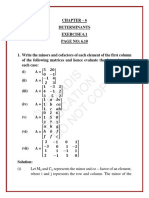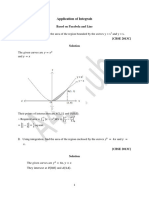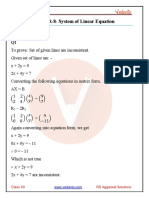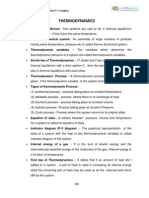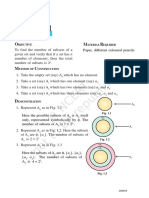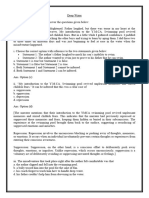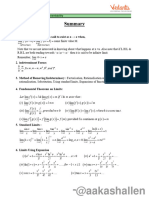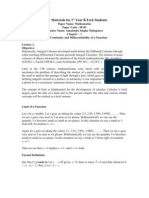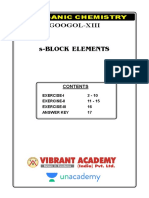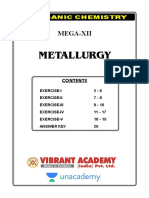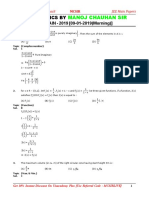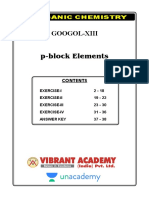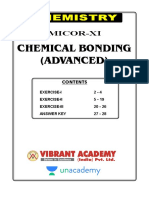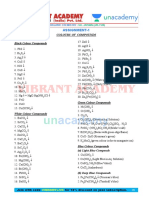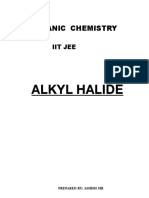0 ratings0% found this document useful (0 votes)
2K views5 pagesLimits Continuity & Differentiability Short Notes
Uploaded by
Anant JainCopyright
© © All Rights Reserved
We take content rights seriously. If you suspect this is your content, claim it here.
Available Formats
Download as PDF or read online on Scribd
0 ratings0% found this document useful (0 votes)
2K views5 pagesLimits Continuity & Differentiability Short Notes
Uploaded by
Anant JainCopyright
© © All Rights Reserved
We take content rights seriously. If you suspect this is your content, claim it here.
Available Formats
Download as PDF or read online on Scribd
You are on page 1/ 5
Short Notes
Limits Continuity and Differentiability
Limit
It is an operator which defines the tendency of the function in
neighbourhood of some point
Let f(x)be the function. If for every positive number €, however
small, there exists a positive number such that whenever
<|x~a| 0)
7 im 149 =e= tim (1+)
og BO
9. im
a
1. Then, £0 ataye aprosces 1 rom ie letthandie.,
009
= Jim,| 82%] =0 where (1 denotes step up tution
[ote at | un, 2%
2 The limit tim, approaches 1 rom RS
= Jn, 80%
nme
where [] denotes step up function
Generalised Formula For 1”
Let lim f(x)=land lim 6 (x)=, then
tin geo se—1)
lim (fone
Proof : We have
T= fim (1+ fo)
v=
= lim | 1+ (f@)-D}. oe)
se Feet
Put f(x)-1= wasr a, y 90
in, gL fo =
Howeveriflim f(x)=4>0 and lim (x)= Ba finite quantity
then lim (0% = 4"
Expansion of Function
Expansion of function like Binomial expansion, exponential and
logarithmic expansion, expansion of sin.x,c0s.x, tan x should be
remembered by heart and ate given below
xing x?In?a, x’ Inta
(at ait a0
" 2 3
ii) ec" 14244 4%
ai) 7
Gi) n)= — Ti for-lexsl
(iv) sinx=
(9) cos x=
Definition of Continuity
Let /(x)bea function defined in the interval [a 6], then itis said to
‘be continuous in [a 6] if and only if its graph never be broken at
any of the points lie in the interval [a 6}
Continuity at Point
‘function f(s) said to be continuous at x=
and = f(a).
Symbolially fis
hy fla A)= lim(arh)= fla) afnte quant,
if tim f(x)exists
continuous at oxsa_ if
be, LHLatr=
quantity
It should be noted that continuity of a function is the property of
interval and is meaningful at= «a only ifthe function hasa graph
in the immediate neighbourhood of x= a,not necessatily at x= a
Hence, it should not be mislead that continuity of @ function is
talked only in its domain.
=RHLatx=a= valueof /(x)atr=a=a finite
Continuity in an Interval
(a) A function f is said to be continuous is (a,b) if f is
continuous at each and every point € (a,b)
(b) A function f is continuous in a closed interval [a, b]if
() Fis continuous in the open interval (a, b)and.
Gi) fis right continuous at ‘a’ Le., im, f(%)= fla)=a
finite quantity we
Gil) Fis left continuous at *B" Le, lim f(x)= f(b)= a
finite quantity os
Types of Discontinuities
There are two types of discontinut
‘Type-I (Removable discontinuity ) : If lim f(x) necessarily
exists, butis either not equal to /(a) or /(a)isnot defined. We say
A(x) is discontinuous and this type of discontinuity is called
Removable Discontinuity.
In this case, therefore itis possible to redefine the function in such
@ manner that lim f(x)= f(a) and thus making the funetion
continuous, These discontinuities can be further classified as
(1) Missing point discontinuity
(2)Isolated point discontinuity
(i) IF fim f(x) exists but /(a)is not defined we say fx)
hhas removable type missing point discontinuity.
Gi) IF fim f(x) exists also f(a) is a Finite number but
slim f0)# fla) we say f(x) has removable type
isolated point discontin
‘Type-2 (Non removable discontinuity)
If lim f(x) does not exists and therefore it is not possible to
redefine
f(x) discontinuous at x= a and such discontinuity is called non
removable discontinuity.
Which is further classified as
(a) Finite type (both limits finite and unequal)
(6) Infinite type (et least one ofthe two limit are infinity)
(©) Oscillatory (limits oscillate between two finite quantities)
Theorems on Continuity
(1) Sum, difference, product and quotient of two continuous
funetions is always a continuous function
fx)
et)
2) If fis continuous and g(a) discontinuous atx = a,then
the product function @(x) = /(x)-g(x) is not necessarily be
discontinuous atx = a
3) If f(2) and g(x) both are discontinuous at x= a, then the
product function @(x)= f(x)-g() is not necessarily be
‘discontinuous at x=
1 function in any manner to make it continuous we say
However
(x)= Lis continuous at x= a only if g(a) #0.
Intermediate Value Theorem :
If fis continuous on [a,b] and f(a) f(b) there for any value
c€ (fla), f(b), there is at least one number xp in (a,) for
which f(x, )=¢
‘Note that continuity through the interval [a, b]is essential for the
validity ofthis theorem.
Extreme Value Theorem
If fis continuous on[a,b]then f takes on, a least value of manda
ereater value M on this interval
Properties of Function Continuous
in La, bl
(1) Ifa function fis continuous on a closed interval [a, b]. then
it is bounded.
2) A continuous function whose domain is some closed
interval must have its range also in closed interval.
8) IF f(a)and_f(bypossesses opposite signs then atleast one
solution of the equation f(x) = Oin the open interval (a, 6)
provided fis continuous ina, b}
(4) If Fis continuous on [a,b], then f~? (from the range of /)
is also continuous.
Single Point Continuity
Functions continuous only at one point and defined
everywhere.
Example
vitxeQ
1) fls)= ‘continuous only at.x= 0
0 s00-[Girees) ious only
Note that point functions are to be treated as continuous
eg. fe)
Continuity of Composite Functions
If iscontinuous atx = aand g is continuous atx = /(a),then the
composite f /(x)] is continuous at x= a.
Ditfrentablty of Functions
L
Geometrical Meaning of Derivative
Slope of the tangent dravin to the curve at x= aif it exists,
Note
“Tangent ata point
isthe limiting case of secant through A
Physical Meaning of Derivative
Instantaneous rate of change of fnetion, Let f(x)isa function and
is continuous at point x= a, then instantanous rate of change of
{fecjat.x= ais denoted by f*(a)and is given by
F(a) jim LO* N= LO) exis
Existence of Derivative
(i) The right hand derivative of fat = adenoted by f(a" is,
defined by
stat y= tim LE+W= £0),
hi
provided the limit exists and is finite
%
Right secant
through
Latsecat oon)
ena ff
ongon Leg
ie
8
fo a
(Gi) The left hand derivative of fatx= a denoted by J” (a is
defined by
im L2=1)- fla)
mh
Provided the limit exists and is finite
if f(a" )=f@ =a
finite quantity, This geomitrically means that a unique
tangent with finite slope can be drawn at x= a as shown in
the figure.
Fis said to be derivable at
Derivability and Continuity
Ifa function is derivable atx
Note.
Iif(x)is derivable for every point ofits domain of definition, then it
is continuous in that domain.
‘The Converse of the above result is not true =
For a function :
Ditferentiabilty —> Continuity; Continuity => derivabilty;
‘Non derivabilty 8 discontinuous But discontinuity —> Non
dorivabilty;
(a) Let f(a" )= pand f’(a)= qwhere pand q are finite then
‘then f is continuous at
() p= 4 fis derivable atx = a= fis continuous atx = a.
Gi) p# g= Fis not derivable at x= a
Itis very important to note that may be still continuous at
(b) Ifa function fis not differentiable but is continuous at x= a
it geometrically implies sharp comer at x=.
Derivabi Open Interval
f(x) is said to be derivable over an open interval (a, 6) if it is
derivable at each and every point of the imterval.,forany point c
such that a
You might also like
- Class 12 Maths 2024-25 Notes Chapter 6. Application of DerivativesNo ratings yetClass 12 Maths 2024-25 Notes Chapter 6. Application of Derivatives43 pages
- Important Questions For CBSE Class 12 Maths Chapter 5100% (1)Important Questions For CBSE Class 12 Maths Chapter 531 pages
- Chap 09 Ray Optics and Optical Instruments (Notes) - Raqczktdgnd8z8lkceiiNo ratings yetChap 09 Ray Optics and Optical Instruments (Notes) - Raqczktdgnd8z8lkceii14 pages
- RS Aggarwal Solutions Class 12 Maths Chapter 5 Matrices Exercise 5CNo ratings yetRS Aggarwal Solutions Class 12 Maths Chapter 5 Matrices Exercise 5C36 pages
- Class XII MATRICES Most Important Questions For 2024-25 Examination (Dr. Amit Bajaj)No ratings yetClass XII MATRICES Most Important Questions For 2024-25 Examination (Dr. Amit Bajaj)67 pages
- Continuity & Differentiability Mind Maps Lakshya JEE 202450% (2)Continuity & Differentiability Mind Maps Lakshya JEE 20241 page
- Class 12 Revision Notes Continuity and DifferentiabilityNo ratings yetClass 12 Revision Notes Continuity and Differentiability22 pages
- Board and Model Case Study Question - Answer KeyNo ratings yetBoard and Model Case Study Question - Answer Key34 pages
- RS Aggarwal Class 12 Solutions Chapter-7No ratings yetRS Aggarwal Class 12 Solutions Chapter-760 pages
- Class 12 Physics Ray Optics and Optical Instruments Boards QuestionsNo ratings yetClass 12 Physics Ray Optics and Optical Instruments Boards Questions15 pages
- League (Cyclic Method 7 Teams Fixture (Odd Teams)No ratings yetLeague (Cyclic Method 7 Teams Fixture (Odd Teams)1 page
- 2025 CBSE XII Maths (Q.P. Code 65-1-1 65-1-2 65-1-3 Series W1XZY)No ratings yet2025 CBSE XII Maths (Q.P. Code 65-1-1 65-1-2 65-1-3 Series W1XZY)24 pages
- RS Aggarwal Class 12 Solutions Chapter-20 Homogeneous Differential EquationsNo ratings yetRS Aggarwal Class 12 Solutions Chapter-20 Homogeneous Differential Equations37 pages
- Mathematics Notes and Formula For Class 12 Chapter 7. IntegralsNo ratings yetMathematics Notes and Formula For Class 12 Chapter 7. Integrals17 pages
- Cbse Class 12 Mathematics Compartment Question Paper 2025No ratings yetCbse Class 12 Mathematics Compartment Question Paper 202543 pages
- Ncert Solutions Class 12 Maths Chapter 1No ratings yetNcert Solutions Class 12 Maths Chapter 166 pages
- Chennai Sahodaya GR 12 PBQPMS 2025-Maths Set 3No ratings yetChennai Sahodaya GR 12 PBQPMS 2025-Maths Set 320 pages
- Class 12 Maths Part II NCERT Textbook 2025-26100% (1)Class 12 Maths Part II NCERT Textbook 2025-26270 pages
- Matrices For Class 12 - Notes, Important Key Points and ExamplesNo ratings yetMatrices For Class 12 - Notes, Important Key Points and Examples14 pages
- CBSE Class 11 Mathematics Revision Notes Chapter-11 Conic Sections100% (1)CBSE Class 11 Mathematics Revision Notes Chapter-11 Conic Sections3 pages
- Maths 12th Chapterwise PYQs - Shobhit NirwanNo ratings yetMaths 12th Chapterwise PYQs - Shobhit Nirwan11 pages
- Class 12 Maths 2024-25 Notes Chapter 5. Continuity and DifferentiabilityNo ratings yetClass 12 Maths 2024-25 Notes Chapter 5. Continuity and Differentiability58 pages
- CBSE Class 12 Physics Deleted Syllabus 2025No ratings yetCBSE Class 12 Physics Deleted Syllabus 20251 page
- Class 12 Maths Notes Chapter 1 Studyguide360No ratings yetClass 12 Maths Notes Chapter 1 Studyguide36011 pages
- Class Xii Mathematics CH 13 Probability Practice Questions50% (2)Class Xii Mathematics CH 13 Probability Practice Questions3 pages
- XII - Deep Water - Notes - 1 - 2023 - 2024No ratings yetXII - Deep Water - Notes - 1 - 2023 - 20249 pages
- Inverse Trigonometry Function - Formula Sheet - MathonGo100% (1)Inverse Trigonometry Function - Formula Sheet - MathonGo7 pages
- Chapter 5 Mathematics - Class 12 - Formula - Sheet100% (1)Chapter 5 Mathematics - Class 12 - Formula - Sheet3 pages
- Handwritten Notes of Inverse Trigonometry Function Bby Kamal Sir 4516819151736510% (1)Handwritten Notes of Inverse Trigonometry Function Bby Kamal Sir 4516819151736515 pages
- Chapter 13 Mathematics - Class 12 - Formula - Sheet50% (2)Chapter 13 Mathematics - Class 12 - Formula - Sheet5 pages
- 20-Limits, Continuity and DifferntiabilityNo ratings yet20-Limits, Continuity and Differntiability14 pages
- 053) Synopsis Continuity, Differentiability, ModNo ratings yet053) Synopsis Continuity, Differentiability, Mod7 pages
- Btech 1st Sem: Maths: Calculus of Single Variable0% (2)Btech 1st Sem: Maths: Calculus of Single Variable11 pages
- Btech 1st Sem: Maths: Limit, Continuity & Differentiability0% (2)Btech 1st Sem: Maths: Limit, Continuity & Differentiability11 pages
- IIT JEE 2019 Organic Chemistry HydrocarbonsNo ratings yetIIT JEE 2019 Organic Chemistry Hydrocarbons38 pages






